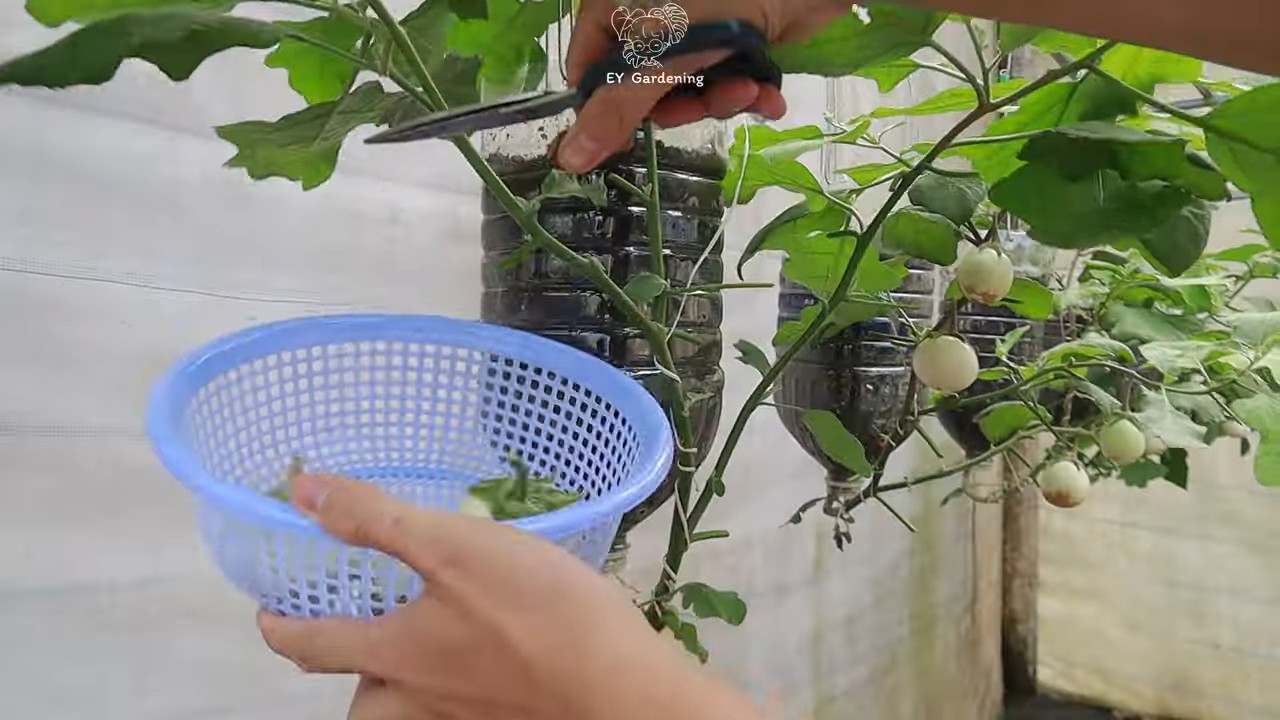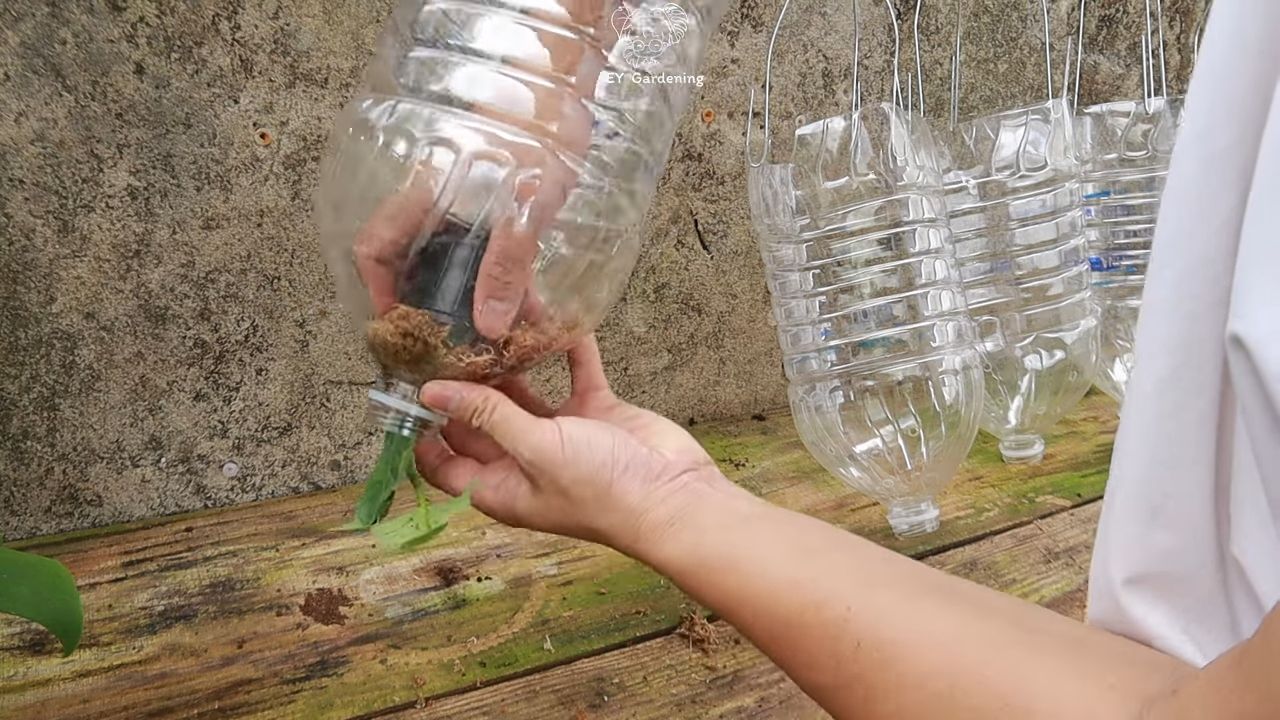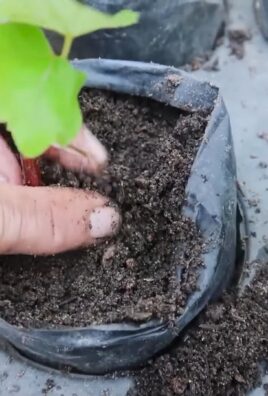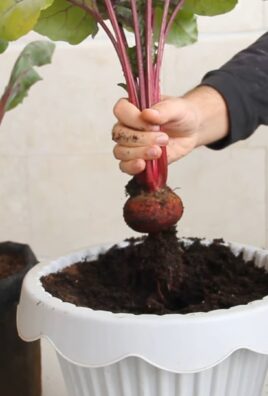Growing White Eggplants might sound like an exotic culinary adventure reserved for seasoned gardeners, but I’m here to tell you it’s surprisingly achievable, even for beginners! Forget those grocery store purple eggplants for a moment. Imagine strolling through your own backyard, plucking a creamy white eggplant, ready to be transformed into a delectable dish. Intrigued? I thought you might be!
Eggplants, in general, have a rich history, tracing back to ancient India where they were first cultivated. Over centuries, they journeyed across the globe, evolving into the diverse varieties we see today. While the familiar purple eggplant dominates supermarket shelves, white eggplants offer a unique aesthetic appeal and often boast a milder, less bitter flavor.
But why should you bother with this particular DIY project? Well, for starters, growing white eggplants allows you to control exactly what goes into your food – no harmful pesticides or questionable growing practices. Plus, there’s an undeniable satisfaction in nurturing a plant from seed to harvest. In this article, I’ll share my tried-and-true tips and tricks for successfully cultivating these beautiful and delicious vegetables in your own home garden. Get ready to impress your friends and family with your newfound gardening prowess!

Growing White Eggplants: A DIY Guide to a Unique Harvest
Okay, so you’re thinking about growing white eggplants? Awesome! They’re not only delicious but also a real conversation starter. I’ve grown them for a few years now, and let me tell you, the process is surprisingly straightforward. This guide will walk you through everything you need to know, from seed to table.
Choosing Your White Eggplant Variety
First things first, let’s talk varieties. Not all white eggplants are created equal! Here are a few popular choices:
* ‘Casper’: This is a classic white eggplant, known for its mild flavor and creamy texture. It’s a reliable producer and a great choice for beginners.
* ‘White Beauty’: As the name suggests, this variety is stunningly white and has a slightly sweeter taste than ‘Casper’. It’s also a bit smaller, making it perfect for smaller gardens or containers.
* ‘Gretel’: This is a hybrid variety that produces clusters of small, white eggplants. It’s incredibly productive and has a delicate flavor.
* ‘Snowy’: This variety is known for its pure white color and excellent flavor. It’s a good choice for grilling or roasting.
I personally love ‘Casper’ because it’s so dependable, but feel free to experiment and find your favorite!
Starting Your Seeds (or Buying Seedlings)
You have two options here: start your own seeds indoors or buy seedlings from a local nursery. Starting from seed gives you more control and is generally cheaper, but it requires a bit more effort.
Starting Seeds Indoors
This is my preferred method because I like to get a head start on the growing season.
* When to Start: Start your seeds about 6-8 weeks before the last expected frost in your area.
* What You’ll Need:
* Eggplant seeds
* Seed starting trays or small pots
* Seed starting mix (a light, well-draining mix is essential)
* A heat mat (optional, but it helps with germination)
* A grow light (also optional, but it ensures strong, healthy seedlings)
* A spray bottle
Step-by-Step Instructions:
1. Prepare Your Trays: Fill your seed starting trays or pots with seed starting mix. Gently press down to firm the soil.
2. Sow the Seeds: Make a small indentation (about 1/4 inch deep) in the soil and place 2-3 seeds in each indentation. Cover lightly with soil.
3. Water Gently: Use a spray bottle to gently moisten the soil. Avoid overwatering, as this can lead to damping off (a fungal disease that kills seedlings).
4. Provide Warmth: Place the trays on a heat mat (if using) and cover them with a humidity dome or plastic wrap to create a warm, humid environment.
5. Provide Light: Place the trays under a grow light or in a sunny window. If using a grow light, keep it a few inches above the seedlings.
6. Monitor and Water: Check the soil moisture daily and water as needed to keep it consistently moist but not soggy.
7. Thin the Seedlings: Once the seedlings have their first true leaves (the second set of leaves), thin them to one seedling per cell or pot. Choose the strongest, healthiest seedling and snip off the others at the soil line.
8. Harden Off: About a week before you plan to transplant the seedlings outdoors, start hardening them off. This means gradually exposing them to outdoor conditions. Start by placing them outside for an hour or two each day, gradually increasing the amount of time they spend outdoors.
Buying Seedlings
If you don’t want to start your own seeds, you can buy seedlings from a local nursery. This is a convenient option, but make sure to choose healthy-looking plants with strong stems and no signs of pests or diseases.
* What to Look For:
* Healthy green leaves
* Strong, sturdy stems
* No signs of pests or diseases
* Well-developed root system (if possible to check)
Preparing Your Garden Bed
Eggplants need plenty of sunshine and well-drained soil. Choose a location that gets at least 6-8 hours of sunlight per day.
* Soil Preparation:
* Amend the soil with compost or well-rotted manure to improve drainage and fertility.
* Eggplants prefer slightly acidic soil with a pH of 6.0-6.8. You can test your soil pH with a soil testing kit and amend it accordingly.
* Remove any rocks, weeds, or debris from the planting area.
Step-by-Step Instructions:
1. Clear the Area: Remove any existing vegetation, rocks, and debris from the planting area.
2. Amend the Soil: Spread a 2-3 inch layer of compost or well-rotted manure over the planting area.
3. Till the Soil: Use a garden fork or tiller to incorporate the compost into the soil to a depth of 6-8 inches.
4. Smooth the Surface: Rake the soil to create a smooth, even surface.
Transplanting Your Seedlings
Once the danger of frost has passed and the soil has warmed up, it’s time to transplant your seedlings into the garden.
* When to Transplant: Transplant your seedlings in the late afternoon or early evening to minimize stress.
* Spacing: Space the plants 18-24 inches apart in rows that are 2-3 feet apart.
Step-by-Step Instructions:
1. Dig the Holes: Dig holes that are slightly larger than the root balls of the seedlings.
2. Remove the Seedlings: Gently remove the seedlings from their containers. If the roots are pot-bound (tightly circling the pot), gently loosen them before planting.
3. Plant the Seedlings: Place the seedlings in the holes and backfill with soil. Gently firm the soil around the base of the plants.
4. Water Thoroughly: Water the seedlings thoroughly after planting.
5. Mulch: Apply a layer of mulch around the plants to help retain moisture, suppress weeds, and regulate soil temperature. I like to use straw or wood chips.
Caring for Your White Eggplants
Eggplants are relatively easy to care for, but they do need regular watering, fertilizing, and pest control.
* Watering: Water deeply and regularly, especially during hot, dry weather. Aim for about 1 inch of water per week.
* Fertilizing: Fertilize every 2-3 weeks with a balanced fertilizer. I like to use a liquid fertilizer diluted to half strength.
* Pest Control: Keep an eye out for common eggplant pests such as aphids, flea beetles, and tomato hornworms. Handpick pests off the plants or use an organic insecticide if necessary.
* Staking: White eggplants can get quite heavy with fruit, so it’s a good idea to stake them to prevent them from falling over. Use bamboo stakes or tomato cages to support the plants.
* Pruning: Pruning isn’t strictly necessary, but it can help improve air circulation and encourage fruit production. Remove any suckers (small shoots that grow from the base of the plant) and any yellowing or diseased leaves.
Specific Care Tips:
* Consistent Watering is Key: Eggplants are thirsty plants. Uneven watering can lead to blossom-end rot, a common problem where the bottom of the fruit turns black and leathery.
* Watch Out for Flea Beetles: These tiny pests can quickly decimate eggplant seedlings. Cover young plants with row covers to protect them.
* Hand-Pollination (Optional): While eggplants are self-pollinating, you can improve fruit set by hand-pollinating the flowers. Use a small paintbrush to transfer pollen from one flower to another.
Harvesting Your White Eggplants
The moment you’ve been waiting for! Harvesting your beautiful white eggplants.
* When to Harvest: Harvest your eggplants when they are firm, glossy, and have reached their mature size. The skin should be smooth and unblemished.
* How to Harvest: Use a sharp knife or pruners to cut the eggplant from the plant. Leave a small stem attached to the fruit.
Step-by-Step Instructions:
1. Check for Ripeness: Gently press the eggplant. It should feel firm and slightly resistant. The skin should be smooth and glossy.
2. Cut the Stem: Use a sharp knife or pruners to cut the stem about 1-2 inches above the fruit.
3. Handle with Care: White eggplants can bruise easily, so handle them with care.
Enjoying Your Harvest

Conclusion
So, there you have it! Growing white eggplants isn’t just a quirky gardening experiment; it’s a gateway to unlocking a world of culinary possibilities and adding a touch of elegance to your garden. From their mild, creamy flavor to their stunning visual appeal, white eggplants offer a unique alternative to their more common purple cousins.
This DIY guide has hopefully demystified the process, showing you that cultivating these beautiful vegetables is well within reach, even for novice gardeners. The key takeaways are simple: choose the right variety, provide ample sunlight and well-drained soil, and be vigilant about pest control. Remember, patience is a virtue when it comes to gardening, and the reward of harvesting your own homegrown white eggplants is well worth the effort.
But don’t stop there! Experiment with different growing techniques. Try companion planting with herbs like basil or thyme to deter pests and enhance flavor. Consider growing your white eggplants in containers if you have limited garden space. You can even try grafting them onto more vigorous rootstock for increased yields. The possibilities are endless!
And when it comes to cooking, let your creativity shine. White eggplants are incredibly versatile and can be used in a wide range of dishes. From creamy dips and flavorful curries to elegant gratins and simple grilled sides, their mild flavor pairs well with a variety of ingredients. Consider using them in place of zucchini or other summer squash in your favorite recipes. Or, try pickling them for a unique and tangy treat.
Ultimately, the best way to discover the magic of growing white eggplants is to simply give it a try. Don’t be afraid to experiment, learn from your mistakes, and most importantly, have fun! We encourage you to embark on this gardening adventure and experience the joy of harvesting your own delicious and beautiful white eggplants.
We’re confident that you’ll be delighted with the results. And once you’ve tasted the fruits (or vegetables!) of your labor, we’d love to hear about your experience. Share your tips, tricks, and favorite white eggplant recipes in the comments below. Let’s build a community of white eggplant enthusiasts and inspire others to discover the joys of growing these unique and delicious vegetables. Happy gardening!
Frequently Asked Questions (FAQ)
What are the main benefits of growing white eggplants compared to purple eggplants?
White eggplants offer several distinct advantages. First, their flavor is generally milder and less bitter than that of purple eggplants, making them more palatable to some people. Second, they have a thinner skin, which means they don’t need to be peeled before cooking. Third, their unique white color adds visual appeal to both the garden and the plate. Finally, some people find them easier to digest than purple eggplants.
What are the best varieties of white eggplants to grow?
Several excellent white eggplant varieties are available, each with its own unique characteristics. ‘Casper’ is a popular choice known for its creamy white skin and mild flavor. ‘White Beauty’ is another reliable variety that produces medium-sized, pear-shaped fruits. ‘Listada de Gandia’ is a beautiful heirloom variety with white and purple stripes. ‘Gretel’ is a compact variety that is well-suited for container gardening. Researching the specific characteristics of each variety will help you choose the best one for your growing conditions and culinary preferences.
How much sunlight do white eggplants need?
White eggplants, like all eggplants, require at least 6-8 hours of direct sunlight per day to thrive. Insufficient sunlight can lead to stunted growth, reduced yields, and poor fruit quality. Choose a sunny location in your garden or, if growing in containers, ensure that they are placed in a spot that receives ample sunlight throughout the day.
What type of soil is best for growing white eggplants?
White eggplants prefer well-drained, fertile soil with a pH between 6.0 and 7.0. Amend your soil with compost or other organic matter to improve drainage and fertility. Avoid heavy clay soils, as they can become waterlogged and lead to root rot. If you have heavy clay soil, consider growing your white eggplants in raised beds or containers.
How often should I water my white eggplants?
Water your white eggplants regularly, especially during hot, dry weather. Aim to keep the soil consistently moist but not waterlogged. Water deeply at the base of the plant, avoiding wetting the foliage, which can increase the risk of fungal diseases. Mulching around the plants can help to retain moisture and suppress weeds.
What are some common pests and diseases that affect white eggplants, and how can I control them?
Common pests that affect white eggplants include aphids, flea beetles, and eggplant lace bugs. These pests can be controlled with insecticidal soap, neem oil, or by introducing beneficial insects like ladybugs. Common diseases include fungal diseases like early blight and verticillium wilt. Prevent these diseases by providing good air circulation, avoiding overhead watering, and using disease-resistant varieties. Crop rotation can also help to prevent soilborne diseases.
When is the best time to harvest white eggplants?
Harvest your white eggplants when they are firm, glossy, and have reached their mature size. The skin should be smooth and unblemished. Gently twist or cut the fruit from the plant, leaving a short stem attached. Overripe eggplants will become soft, seedy, and bitter.
Can I grow white eggplants in containers?
Yes, white eggplants can be successfully grown in containers, especially compact varieties like ‘Gretel’. Choose a large container (at least 12 inches in diameter) with drainage holes. Use a high-quality potting mix and provide regular watering and fertilization. Container-grown eggplants may require more frequent watering than those grown in the ground.
How can I use white eggplants in cooking?
White eggplants are incredibly versatile and can be used in a wide range of dishes. They can be grilled, roasted, fried, sautéed, or used in dips, curries, and gratins. Their mild flavor pairs well with a variety of ingredients, including garlic, herbs, tomatoes, and cheese. Try using them in place of zucchini or other summer squash in your favorite recipes.
How do I store white eggplants after harvesting?
Store white eggplants in the refrigerator for up to a week. Wrap them loosely in plastic wrap or place them in a perforated plastic bag to prevent them from drying out. Avoid storing them near ethylene-producing fruits like apples and bananas, as this can cause them to ripen too quickly.





Leave a Comment